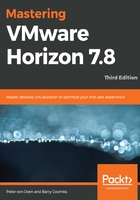
VMware UEM
The VMware UEM product is one of the newest editions to the Horizon portfolio and was added when VMware acquired the Dutch company Immidio back in February 2015. Immidio was a software company that created products that were aimed at helping their consultants out in the field, with the core product being called Flex+.
UEM adds additional functionality over and above the standard persona management solution, providing a central management console, to deliver personalization of the end user's virtual desktop machine as well as the ability to dynamically configure policies. It works across several different environments, such as virtual desktop machines, physical PCs, as well as cloud-based Windows desktop environments or DaaS. It's all about managing Windows profiles regardless of where or how the operating system runs.
There are five key use cases that UEM can be used with:
- Application Configuration Management: Allows you to configure an application's initial settings rather than deploying the application's own default settings. You can configure predefined settings as one-time defaults, fully enforced (application starts with the user's personalized settings every time), or partially enforced (application starts as configured, but allows the user to perform limited personalization), using the VMware UEM Application Profiler to capture predefined settings for an application.
- User Environment Settings: Allows you to centrally manage user environment settings such as the following:
- Application blocking
- Application shortcuts and file type associations
- Drive and printer mappings
- Environment variables
- Files, folders, and registry settings
- Folder redirection
- Personalization: Abstracts user-specific desktop and application settings from the underlying OS and then makes these settings available across multiple devices, Windows versions, and applications. It also supports operating system migration such as Windows 7 or Windows 10.
- Application Migration: Allows an end user to effectively have roaming application and personalization settings so that they can move between different operating system versions, such as from Windows 7 to Windows 10.
- Dynamic Configuration: Using condition sets allows you to combine conditions based on variables such as user, location, and device, to deliver dynamic delivery of content and appearance, for example, delivering access to a network printer based on an end user's location, or to create drive mapping that is based on the user's identity.
SmartPolicies is a feature of Horizon and uses UEM to deliver a set of policies that are specific to virtual desktop machines.
To use SmartPolicies, it is recommended that you run View Connection Server Version 7.2 or later and is required for using Smart Policies with RDSH-published applications. You also require UEM 9.0 or later, but UEM 9.2 or later is recommended.
With Smart Policies, administrators have a more granular level of control over an end user's virtual desktop machine. Horizon 7 features can be dynamically enabled, disabled, or controlled based on the end user as well as other variables, such as the client device type, IP address, and desktop pool name. With SmartPolicies, you can configure the following:
- USB redirection
- Printing
- Clipboard behavior
- Client drive redirection
- HTML access file transfer
- Bandwidth profile